
Published in the April 2015 issue of “Die Porsche Kassette”
A lot of hot air is what can save your life in case of a frontal crash if you have one of the earlier Porsche Airbags.
Actually, hot nitrogen, produced by a chemical reaction in the Airbag.
Have you ever wondered how airbags work? What if any is their maintenance? or, Have you heard that you shouldn’t use a full face helmet in conjunction with an airbag?
Keep on reading and we’ll fill you up, I mean fill you in ;)
The goal of an airbag is to slow the passenger’s forward motion as evenly as possible in a fraction of a second when a crash occurs, because as we all know speed doesn’t kill, it’s the sudden stop that gets you.
In 1987 Porsche introduced the first automobile in the world to have as standard equipment driver and passenger airbags. That car was the 944 Turbo. The 944 and 944 S offered Airbags as optional equipment that same year.
Eleven years later, in 1998, the National Highway Traffic Safety Administration (NHTSA) mandated as standard equipment dual frontal airbags in cars and a year later in light trucks as well.
The airbag is made of thin nylon material which is folded into the steering wheel, the passenger dash the doors and or the seats.
The sensor is what triggers the airbag to inflate. It sends the signal when there is a collision force equal to running into a cement wall at 10 -15 mph.
The sensor receives the information from an accelerometer built into a microchip.
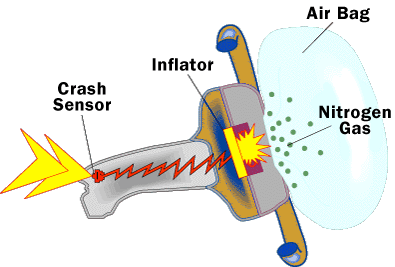
The airbag’s inflation system reacts potassium nitrate (KNO3) with sodium azide (NaN3) to produce nitrogen gas which inflates the bag.
Think of the airbag inflation system as a solid rocket booster. The airbag ignites a solid propellant which burns very rapidly and creates a large volume of gas to inflate the bag. The airbag actually bursts from its storage at up to 200 mph. A second later the nitrogen gas dissipates through small holes in the bag which completely deflates it.
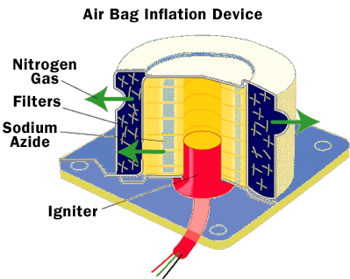
Today, the technology has evolved to also include side impact airbags, curtain airbags, side tubular airbag knee airbags and others to further protect the vehicle’s occupants. The technology also changed so that today’s airbags produce cool nitrogen, not hot gas.
From impact to full deployment, a driver’s airbag takes approximately 30 - 40 milliseconds (0.030 - 0.040 second) - an eye blink takes 0.2 second - while the passenger airbag, which is larger, takes 40- 80 milliseconds to inflate.
Side impact airbags must inflate and deploy much quicker because there is no crumple zone and very little space between the passenger and the door. Side-collision detection must take place within 3 milliseconds (0.003 second) and complete deployment of the side or curtain airbags must happen within 10 - 15 milliseconds (0.010 - 0.015 second).
These side airbags can deploy much quicker because they don’t depend on a chemical reaction as with the frontal bags. They have their own high-pressure gas canisters and the gas is released cold.
Porsche uses a combination of airbags in their vehicles to protect its passengers:
Aside from the frontal driver and passenger airbags, The Porsche Side Impact Protection (POSIP) system on the sport cars comprises side impact protection elements in the doors and two airbags in each side.
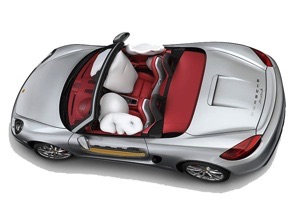
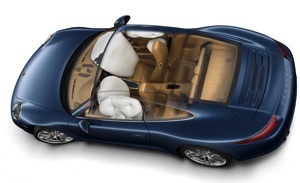
The Macan, for instance, is equipped with full-size frontal airbags just like the sports cars, but also offers driver and passenger knee airbags and the POSIP includes side airbags in the front seats, curtain airbags along the entire roof frame and the side windows from the A-pillar to the C-pillar, and side airbags for the rear compartment.
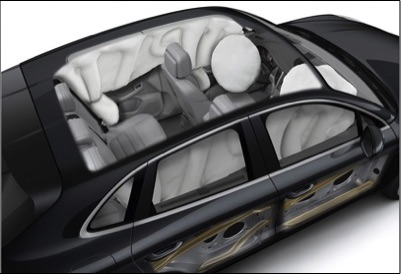
Regarding maintenance, Porsche’s airbag systems are very well made and are supported by a very sophisticated self-diagnostic capability. Even the very early airbag systems will detect minute changes within the system and return an error message or warning light if specific electronic values are exceeded or operational issues are detected. If your airbag warning light lights up when you turn on the ignition and then goes off by itself a few seconds later, your airbag system is ready to work for you.
Porsche recommends inspecting the airbag system eight years after manufacture and every two years thereafter for the life of the car. Porsche does not recommend replacing airbags at any specific time interval, only when, if ever, they are inflated.
And the one about not using a full-face helmet in conjunction with an airbag.
Myth or fact?
If you are using a three-point restraint (shoulder/lap seatbelt) such as on a DE or AX there is no problem in using a full face helmet.
If you are using a racing seat with a five or six point restraint harness you should not have an operational airbag.
The reason is that with a 3-point seatbelt, in a frontal crash, your torso will move forward as the belt tightens and stretches a bit, aligning your chest with the inflating airbag, as it was designed.
With a 5 or 6 point restraint your torso will not move forward appreciably, just your head. This puts your chin in line with the inflating bag which can catch the edge of the helmet’s chin protection area and snap your head back!
That’s why you don’t find airbags in racecars.

Also remember that the airbag system is not a substitute for seatbelts. They are designed to work together making your car safer for your and your passenger(s).
For more information on airbags and more, please visit my website: www PedrosGarage.com.
Happy Porsche’ing,
Ⓒ2015 Technolab / PedrosGarage.com


